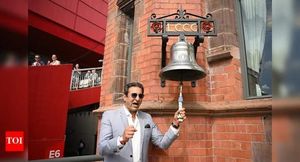Coca-Cola, the iconic beverage giant, has stirred up quite the controversial buzz this holiday season with its newly released advertisement, which is uniquely generated by artificial intelligence. While Coca-Cola’s traditional holiday ads, especially the widely loved 1995 “Holidays Are Coming” spot, are recognized for their nostalgic charm and festive spirit, this latest attempt has not melted hearts the way its predecessor did. Instead, many find it lacking depth, soul, and the warm characters typically associated with the season.
The fresh twist on the classic ad features the same concept of Coca-Cola trucks illuminated with holiday lights, traveling through snowy streets to spread cheer. The soundtrack, promising “It’s always the real thing,” clashes sharply with the reception of this new version, which many instantly described as “creepy” and “embarrassing.”
According to Javier Meza, Coca-Cola’s European Chief Marketing Officer, the initiative to modernize the beloved holiday advertisement involved experimenting with AI technology, rather than making it the focal point from the get-go. “We didn’t start by saying: ‘OK, we need to do this with AI,’” he expressed during conversations with Marketing Week, emphasizing the goal was to update the holiday spirit for today's audience.
Commentary across social media platforms has been predominantly scathing. Fans of the traditional holiday commercials took to platforms like X, formerly known as Twitter, expressing their disappointment. Comments such as “This looks like slop,” and “It’s as heartwarming as an aluminum tree,” paint the picture of how out of touch this ad seems with its audience. When comparing the authenticity of past fan recreations of the classic ad, one user jeered, “Over 14 years ago, people recreated the Coca-Cola Christmas ad in GTA San Andreas and it still came off as more authentic than this tripe.”
One particularly pointed critique from user @joerussotweets remarked, “Coca-Cola decided to have its polar bears take a giant AI shit under the Christmas Tree,” reflecting the overall sentiment of disillusionment with the use of AI for such culturally significant ad content.
This decision to employ AI has triggered broader discussions within the industry. Critics point out not only the artistic shortcomings but also the ethical ramifications of using technology to replace human creativity. Many feel it sets a concerning precedent for future advertising where big corporations might lean on AI instead of investing in human talent. One individual questioned, “If Coca-Cola, part of the Fortune 500, can’t hire real artists, what does this mean for the rest of the market?”
Despite the overwhelming negative feedback online, Jason Zada, the founder of one of the AI studios involved with the project, defended its creation by focusing on efficiency rather than emotional resonance. He touted AI’s ability to drastically cut production time compared to traditional methods, allowing for faster and cheaper advertisement outputs. While some may see this as progress, others believe it undermines the deeply human connections these holiday ads are meant to invoke.
Adding fuel to the fire is the unfortunate timing of the campaign. Current AI controversies loom large over various industries, where disputes over artistic integrity and job security are still fresh, thanks to the Hollywood writers' and actors' strikes over the use of AI. This backdrop of tension has rendered Coca-Cola’s AI-generated ad not just another marketing flop but also part of larger debates surrounding AI's role across creative services.
The criticism culminated to such extremes wherein calls for boycotting the brand were echoed among users, warning about the potential loss of loyal customers to competitors such as Pepsi. “Coca-Cola has lost its holiday spirit. It may lose some soda drinkers to Pepsi, solidifying the fact they’re banned from consumers’ holiday seasons,” one Twitter user highlighted.
To date, Coca-Cola has not issued any formal response to the backlash, leaving many to wonder if this AI experiment was simply too off-mark and if it has tarnished the image of the beloved brand as it vies to remain relevant amid changing times.
This holiday campaign suggests just how complex the balance of tradition and innovation has become, especially when it involves something as timeless as holiday cheer.



